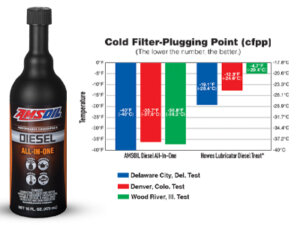02 Feb Prevent Diesel-Fuel Gelling This Winter
Cold-Flow Improvers keep the diesel fuel flowing and your diesel truck rolling.
We’ve now entered the frigid season and for those burning diesel fuels, cold-temperature issues come up.Also, diesel owners also have to be careful of what comes out of the diesel pump at the fuel station.
Diesel Fuel Can Gel In Winter
Diesel fuel contains naturally occurring wax that solidifies in cold temperatures. Normally the wax is in liquid form, and due to its importance, we definitely want it in the fluid solution. When temperatures drop, wax crystals form and cling to one or other. As temperature continues to decrease, formation of wax continues until it restricts the flow of fuel through the fuel filters, eventually stalling out the engine. Wax formation in fuel is commonly known as “gelling”. Depending on the fuel, gelling can occur at temperatures just under 32°F (0 degree C).
Cold-Weather Terminology
In addition to gelling a few other common terms described diesel cold weather performance:
- Cloud Point – The temperature at which wax crystals begin to form in diesel fuel. This is normally around 32°F for number two diesel fuel, but can be as high as 40°F.
- Cold Filter Plugging Point (CFPP) – the point at which wax crystals are allowed to form in untreated diesel fuel which clogs the fuel filter.
- Pour Point – the lowest temperature at which fuel maintains its ability to fl
Amsoil is Number One
The ultra-low sulfur diesel at every pump must meet certain CFPP characteristics to help protect drivers. Refineries typically achieve this by producing winter blend diesel.
Winter blend diesel is simply the standard #2 diesel fuel available at fuel stations everywhere mixed with some percentage of #1 diesel fuel. Number one diesel contains less wax and offers cloud and pour points of typically-20°F or colder, making it preferable in cold weather.
So, why not just use #1 diesel in the winter? #1 diesel produces approximately 95% the energy output of #2 diesel, reducing fuel economy and horsepower, which is undesirable and a lot more expensive to make. Also, the refinery would pass the additional cost on to the consumer, and again, that would be undesirable.
Weather Is Inherently Unpredictable
Winter blend diesel (#2) does a decent job preventing gelling, but it’s not foolproof. That’s because refiners typically based the fuels rating on temperature projections that don’t leave room for sudden and violent temperature swings. In northern Minnesota, the temperature can easily go from 40°F to below zero in hours. Even if the winter blend diesel (#2) is available at the nearest fuel station and is blended for those temperatures, the fuel could still gel.
Use Cold Flow Improvers
Be prepared in cold temperatures. Rather than tempt fate, use a diesel fuel additives formulated to prevent gelling. Amsoil diesel all in one is the perfect solution. In addition to providing potent determinacy and lubricity to clean and lubricate injectors for maximum fuel economy and power, it contains cold flow improvers that help prevent wax formation and settling. As a result it guards against gelling to keep your diesel up and running despite frigid cold.
How does it compete with the competition. Diesel all in one provides as much as 32°F better protection against cold temperature gelling than Howes Lubricator Diesel Treat.
For the best protection this winter, use Diesel-All-in-One at every fill-up. That’s one thing less to worry about.

The Lower the Temperature, the better

